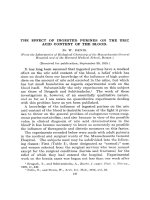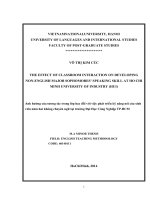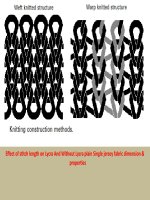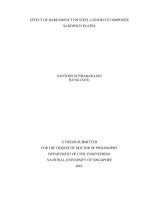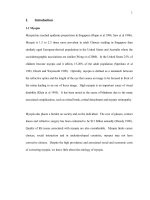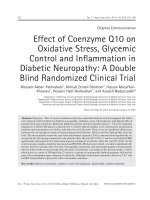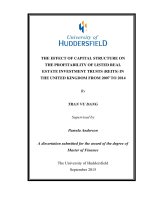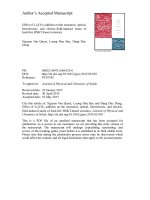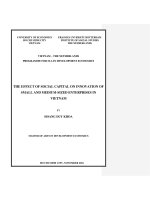Effect of microclimate alteration on temperature humidity index (THI), milk production and milk composition in Jaffrabadi buffaloes during summer
Bạn đang xem bản rút gọn của tài liệu. Xem và tải ngay bản đầy đủ của tài liệu tại đây (239.31 KB, 7 trang )
Int.J.Curr.Microbiol.App.Sci (2019) 8(4): 1379-1385
International Journal of Current Microbiology and Applied Sciences
ISSN: 2319-7706 Volume 8 Number 04 (2019)
Journal homepage:
Original Research Article
/>
Effect of Microclimate Alteration on Temperature Humidity Index (THI),
Milk Production and Milk Composition in Jaffrabadi
Buffaloes during Summer
B.D. Savaliya*, S.S. Parikh, R.B. Makwana, T.K. Patbandha,
P.M. Gamit and K.S. Murthy
Cattle Breeding Farm, Junagadh Agricultural University, Junagadh-362001, Gujarat, India
*Corresponding author
ABSTRACT
Keywords
Temperaturehumidity index,
Rectal temperature,
Respiration rate,
Milk yield, Fat
percent
Article Info
Accepted:
12 March 2019
Available Online:
10 April 2019
In the current scenario, climate change is occurring all over the world and heat stress is
increasing gradually. Heat stress can effectively reduce in buffaloes through evaporative
cooling. Present experiment was carried out to find out the effect of fogger cooling on
Temperature-Humidity Index (THI), physiological parameters, milk yield and milk
composition in Jaffrabadi buffaloes during summer season at Cattle Breeding Farm,
Junagadh Agricultural University, Junagadh, Gujarat (India) for a period of 9 weeks(from
April to June, 2017). Thirty lactating Jaffrabadi buffaloes were divided in two groups of 15
each. Buffaloes of Group-I (control) were kept under loose housing without any cooling
system, while buffaloes of Group II (experiment) were kept under loose housing with
fogger cooling system operated from 11.00 a.m. to 4.00 p.m. Significantly (P<0.05) lower
THI value was observed in Group II buffalo shed. Though the difference was nonsignificant, lower rectal temperature and respiration rate were observed in the buffaloes of
fogger group compared to control group. Milk yield and fat percent were increased
significantly (P<0.05) in Jaffrabadi buffaloes of group II. Thus, it is concluded that the
fogger cooling system was beneficial in terms of body comfort of the animals by reducing
heat stress as well as increasing milk yield and fat percent in Jaffrabadi buffaloes during
summer season.
Introduction
In the current scenario, climate change is
occurring all over the world. Thermal stress is
become a major limiting factor in livestock
production under tropical climate during the
summer season. Buffaloes are more prone to
physical distress as they have poor heat
tolerance due to scarcely distributed sweat
glands and black body colour (Das et al.,
1999).
The
innate
thermoregulatory
mechanism in buffaloes is inadequate
compared to cattle (Tharar et al., 1982). It is
well known fact that adequate heat dissipation
is essential for the maintenance of normal
body temperature and normal functioning of
the organs (Verma and Hussain, 1991). Heat
stress leads to increased rectal temperature
and subsequent decrease in feed and energy
intake and the average effects on
1379
Int.J.Curr.Microbiol.App.Sci (2019) 8(4): 1379-1385
reproduction,
milk
production
composition (AI Said et al., 2000).
and
During summer, wetting of buffaloes can
effectively reduce body temperature and
respiration rate through cooling, which can
achieved
by
wallowing,
showering,
sprinkling, mud plastering and some modern
technologies like misters and foggers. Fogger
cooling system was found beneficial in terms
of the body comfort and the milk yield in
Murrah buffaloes (Ambulkar et al., 2011).
Foggers cooling system in summer was found
beneficial in terms of body comfort as well as
increasing the fat yield in Mehsana buffaloes
(Jegoda et al., 2015). Fogger system consists
of nozzles in a line placed 8-9 ft. above the
floor. This system disperses very fine water
droplets and cools the air in the barn and body
surface. Scarce information is available on
microclimate alteration by fogger cooling
system on milk yield and body comfort in
Jaffrabadi buffaloes during summer. Hence
the investigation was undertaken to find out
the exact effect of microclimate alteration to
counteract the heat stress effect of summer.
Materials and Methods
The present study was conducted on thirty
lactating Jaffrabadi buffaloes for the period of
9 weeks (8th April to 15th June, 2017) at Cattle
Breeding Farm, Junagadh Agricultural
University Junagadh. The buffaloes were
divided into two groups fifteen each on the
basis of body weight, daily milk yield and
parity. Initial body weight of the buffaloes in
group I and group II were 575.00±14.26 kg
and 573.26±20.47 kg, respectively. Buffaloes
of group I were kept under loose housing
without foggers (Control), while buffaloes of
group II were kept under loose housing with
foggers (experiment). This fogger system
consisted of plastic fogger (NETAFIM brand)
nozzles which were arranged in a line and
placed 8 feet above the floor. The fogger
cooling system was automatically controlled
by an electronic timer and run for 3 minutes
after an interval of every 2 minutes, operated
daily during high atmospheric temperature
hours in experimental shed from 11:00 to
16:00 hrs. Feeding requirements were
calculated on the basis of average milk
production and maintenance requirements as
per ICAR (2010) feeding standards.
Throughout the study period, animals were
maintained under similar feeding and other
farm managerial practices under loose
housing system of management. Experimental
animals were dewormed at regular interval
and vaccinated against endemic diseases.
Milk production during morning and evening
was recorded daily on electronic weighing
machine. Weekly milk samples of 100 g from
each buffalo were collected and analysed for
fat, solid-not-fat, protein, lactose and ash
content by using Ultrasonic Milk Analyzer
(Lactoscan, Milkotronic Limited, Bulgariya).
Physiological
responses
viz.
rectal
temperature and respiration rate were
measured weekly by clinical thermometer and
the flank movements /minute, respectively, at
8:00, 11:00, 15:00 and 18:00 hrs to assess the
body comfort. A Data Logger (HTC brand)
was placed in the centre of the experimental
shed at 8 feet height from the floor to record
maximum and minimum temperature and
relative humidity at one hour interval during
whole experimental period to calculate
Temperature-humidity index (THI).
Statistical analysis
Statistical analysis of experimental data was
carried out by using two-sample ‘t’ test with
equal variances as per the methods suggested
by Snedecor and Cochran (1994)
Temperature-humidity index (THI) was
calculated according to the equation reported
by Ravagnolo et al., (2000):
1380
Int.J.Curr.Microbiol.App.Sci (2019) 8(4): 1379-1385
THI = (1.8 × T + 32) –[(0.55− 0.0055 × RH)
× (1.8 × T –26)]
was helpful in thermoregulation in Jaffrabadi
buffalo.
Where, T=air temperature
RH=relative humidity (%)
Similar findings of decreased rectal
temperature of 102.2°F was reported by
Agarwal (2004) in dairy cows kept in houses
equipped with mister cooling compared to
without mister cooling system (103.84°C).
Rectal temperature values of 38.5°C and
39.3°C in cows (Boonsanit et al., 2010) and
38.7 and 39.4°C in crossbred cows
(Chanpongsang et al., 2010) and 38.5±0.3°C
and 39.3±0.3°C in dairy cattle (Siriwat et al.,
2013)
provided
with
and
without
supplemental cooling system, respectively,
were consistent with the present results.
(°C)
and
Results and Discussion
Temperature Humidity Index (THI)
Temperature-humidity index (THI) was used
as an indicator of thermal comfort for dairy
animals. The average THI values recorded in
group I (control) and group II (experiment)
were 84.42 and 78.66 respectively (Table 1).
The peak THI value in group I and II were
85.75 and 80.48 respectively and was reached
at 6th week of the experiment during May2017 in both the experimental buffalo sheds.
Significant (P<0.05) difference in the THI
values was observed between the groups.
Agarwal (2004) reported decreasing THI
values from 84.1 to 82.78 in Murrah buffalo
houses and Chanpongsang et al., (2010)
revealed decreasing THI values from 81 to 77
in cattle houses due to mister cooling,
supported the present results. Frazzi et al.,
(2000) reported dairy cattle barns equipped
with fans and fans plus misting recorded
temperatures of 31.5°C and 30.9°C,
respectively supporting the findings of
effectiveness of evaporative cooling system in
decreasing the temperature in cattle houses
over air circulation by fans alone.
Respiration rate
The buffaloes in fogger cooling shed showed
reduced respiration rate (21.46) at 3:00 pm
(peak hot hours) by 4.09 counts/minute as
compared to that of control group (25.55).
The difference was non-significant but
lowered respiration rate in buffaloes under
fogger shed might be due to decrease in heat
stress due to cooling effect caused by
provision of foggers. Decreased respiration
rate due to provision of foggers reported in
dairy cows (Correa-Calderon et al., 2002;
Boonsanit et al., 2010) and buffaloes
(Agarwal, 2004; Ambulkar et al., 2011) were
in consistent with the present findings.
Milk yield
Body temperature
ᵒ
Lower body temperature (99.58 F) was
observed in Jaffrabadi buffaloes maintained
under fogger cooling than the buffaloes
maintained without any cooling system
(101.09ᵒ F) during peak hot hours (at 3:00
pm). Though the difference was nonsignificant, fogger cooling had reduced body
temperature of buffaloes by 1.5 ͦ F at the peak
hot period suggesting that the fogger cooling
The average weekly milk yield of Jaffrabadi
buffaloes maintained under fogger cooling
was 50.33±1.36 kg. This was significantly
(P<0.05) higher as compared to the milk yield
of the buffaloes maintained without any
cooling devices (44.81±1.58 kg) (Table 2,
Figure 1).
The buffaloes under fogger cooling system
showed increased daily milk yield by 0.790
1381
Int.J.Curr.Microbiol.App.Sci (2019) 8(4): 1379-1385
kg/day/buffalo (12.32 %). It suggests that
fogger cooling helped in reducing the heat
stress and thereby augmented milk production
significantly in Jaffrabadi buffaloes.
Table.1 Effect of fogger cooling on Temperature Humidity Index (THI)
in Jaffrabadi Buffalo during summer
Period
(Weeks)
Temperature-Humidity Index
(THI)
Group-I
Group-II
(Control)
(Experiment)
1st
2nd
3rd
4th
5th
6th
7th
8th
9th
Mean±SE
82.96±0.31
82.34±0.31
83.15±0.36
84.65±0.15
85.21±0.29
85.75±0.23
85.53±0.24
84.77±0.30
85.46±0.12
84.42± 0.38a
75.82±0.21
77.69±.032
76.15±0.13
79.73±0.41
80.42±0.32
80.48±0.24
79.02±0.25
78.12±0.31
80.53±0.26
78.66±0.51b
Means bearing different superscript (a, b) in a row differ significantly (P<0.05).
Table.2 Effect of fogger cooling on milk production in Jaffrabadi Buffalo during summer
Weeks
1
2
3
4
5
6
7
8
9
Mean±SE
Daily Av.
Weekly milk
production/buffalo (kg)
Control
Experiment
51.59±4.91
52.49±7.26
48.91±4.41
54.60±6.03
48.23±4.33
54.70±5.47
47.20±4.03
53.20±5.25
45.70±3.98
51.60±5.02
43.20±3.78
49.40±5.13
41.97±3.73
48.30±5.25
38.75±3.53
45.40±5.12
37.70±3.37
43.20±5.16
a
44.81±1.58
50.33±1.36b
6.4±0.15
7.19±0.21
Means bearing different superscript (a, b) in a row differ significantly (P<0.05).
1382
Int.J.Curr.Microbiol.App.Sci (2019) 8(4): 1379-1385
Table.3 Weekly mean values of milk composition in Jaffrabadi buffalo
Control-Milk constituents (%)
Experiment – Milk constituents (%)
Fat SNF
TS Protein Lactose Ash
Fat SNF
TS Protein Lactose Ash
8.15 11.45 19.90
4.30
6.44
0.96 8.15 11.89 20.04
4.18
6.40
0.97
1
8.15
11.65
19.87
4.32
6.49
0.98
8.32
11.80
20.13
4.75
6.24
0.99
2
8.13 11.85 19.85
4.26
6.44
0.99 8.43 11.82 20.23
5.07
6.72
0.98
3
8.17 11.76 19.89
4.42
6.56
0.97 8.51 11.70 20.22
4.39
6.46
0.97
4
8.12 11.79 19.84
4.24
6.78
0.98 8.61 11.67 20.28
4.31
6.58
0.96
5
8.14 11.68 19.86
4.37
6.32
0.94 8.47 11.71 19.98
4.11
6.76
0.97
6
8.11 11.96 20.08
4.39
6.54
1.01 8.70 11.67 20.37
4.42
5.99
1.02
7
8.15 11.72 19.87
4.29
6.21
0.95 8.68 11.61 20.28
4.45
6.85
0.98
8
8.18 11.94 20.14
4.38
6.28
1.01 8.69 11.75 20.37
4.33
6.75
0.97
9
a
b
Mean 8.15 11.78 19.92
4.30
6.47
0.98 8.51 11.72 20.21
4.31
6.28
0.99
SE
0.007 0.035 0.036 0.018
0.015 0.007 0.063 0.028 0.046 0.002
0.075 0.009
Week
Means bearing different superscript (a, b) in a row differ significantly
Significant (P<0.05)
Fig.1 Effect of fogger cooling on milk production in Jaffrabadi Buffalo during summer
Milk composition
Weekly overall mean values of milk fat
percent was significantly (P<0.05) higher
(8.51±0.06) (4.4%) in experiment group of
Jaffrabadi buffaloes as compared to control
group of buffaloes (8.15±0.01). Other milk
constituent viz. SNF, TS, Protein, lactose and
ash did not differ significantly (Table 3).
Agarwal (2004) reported that the milk
production in Murrah buffaloes was 7.58 and
8.60 in control (allowed for wallowing) and
mister system, respectively. Similarly, milk
production of 16.9±1.9 and 12.6±0.6 kg/day
were reported by Chanpongsang et al., (2010)
in crossbred primiparous cows housed under
evaporative cooling housing system and open
1383
Int.J.Curr.Microbiol.App.Sci (2019) 8(4): 1379-1385
housing system. Milk yield of 5.63 kg and
5.32 kg in Murrah buffalo maintained under
the high-pressure fogger system and control,
respectively, were reported by Ambulkar et
al., (2011) which corroborate with the present
findings.
In conclusion, the result showed that fogger
cooling in the buffalo shed reduced heat stress
due to evaporating cooling effect of water.
Milk yield and fat percent were increased
significantly in Jaffrabadi buffaloes during
hot summer season. Physiological and
environmental
parameters
viz.
rectal
temperature, respiration rate and THI value
were lowered in buffaloes under fogger shed
by 1.51ᵒ F, 4.09 counts/minute and 5.76 THI,
respectively, during peak hot hours in
summer. Therefore, it is concluded that the
fogger cooling system was beneficial in terms
of body comfort of the animals as well as
increasing milk yield and fat percent in
Jaffrabadi buffaloes during summer season.
References
Agarwal, A. 2004.Effect of environment on
hormones, blood metabolites, milk
production and composition under two
sets of management in cows and
buffaloes. PhD thesis submitted to
National Dairy Research Institute,
Karnal (Haryana), India.
Al Saied, A.M., Habeeb, M.K.I., Yousef,
H.M. 2000.Blood and milk contents of
Triiodothyromine (T3) and cortisol in
lactating buffaloes and change in milk
yield and composition as a function of
lactation number and ambient
temperature.
Arab
J
Nuclear
SciApplic.33 (2): 313-322
Ambulkar, D.R., Nikam, S.D.,Barmase,B.S.,
Ali, S.Z and Jirapure, S.G. 2011.Effect
of a high-pressure fogger system on
body comfort and milk yield in
Murrah buffaloes during the summer.
Buffalo bulletin.30 (2):130-38.
Boonsanit, D., Chanpongsang, S. and
Chaiyabutr, N. 2010.Effects of
supplemental recombinant bovine
somatotropin (rbST) and cooling with
misters and fans on renal function in
relation to regulation of body fluids in
different stages of lactation in
crossbred Holstein cattle. AsianAustralian
Journal
of
Animal
Science.23:355-365.
Chanpongsang, S., Choktananukul, V.,
Jamikorn, U., Chaiyabutr, N. and
Suadsong, S. 2010. Effects of
Evaporative Cooling System on
Productive
and
Reproductive
Performance and some Physiological
Parameters of Crossbred Holstein
Friesian Cattle in Tropical Conditions,
Sustainable Improvement of Animal
Production and Health. Food and
Agriculture Organization of the
United Nations, Rome, pp: 105–110.
Correa-Calderon, A., Avendano-Reyes, L.,
Rubio-Villanueva, A., Armstrong,
D.V., Smith, J.F. and DeNise, S.K.
2002.Effect of a cooling system on
productivity of Holstein cows under
heat stress. Agrociencia (Montecillo)
36: 531.
Das, S.K., Upadhyaya, R.C. andMadan, M.L.
1999. Heat stress in Murrah buffalo
calves. Livest Prod Sci., 61(1):71-78
Frazzi, E., Calamari, L., Calegari, F. and
Stefanini, L. 2000.Behavior of dairy
cows with different barn cooling
systems. Transactions ASAE.43:387–
394.
ICAR, 2010. Nutrient Requirement of cattle
and buffalo. Third revised edition.
Indian Council of Agricultural
Research, KrishiBhavan, New Delhi,
India.
Jegoda, M.N., Patel, J.B., Prajapati, K.B. and
Ankuya, K.J. 2015.Effect of foggers
on production performance and feed
1384
Int.J.Curr.Microbiol.App.Sci (2019) 8(4): 1379-1385
intake of Mehsana buffaloes in
summer. Indian J. Dairy Sci.,
68(4):376-378.
Ravagnolo, O., Misztal, I. and Hoogenboom,
G. 2000. Genetic component of heat
stress in dairy cattle, development of
heat index function. J. Dairy Sci.,
83:2120–2125.
Siriwat, S., Thuchadaporn, C. and Junpen, S.
2013. Effect of Improved Cooling on
Daily
Rhythmicity
of
Body
Temperature in Cross-bred Holstein
Dairy
Cows
under
Tropical
Conditions. Thailand Journal of
Veterinary Medicine. 43(3): 367-373.
Snedecor, G.W. and Cohran, W.G.
1994.Statistical Methods. 8th ed.
Affiliated East West Press Pvt. Ltd.,
New Delhi, India.
Thahar, A., Moran J.B., Seripto. 1982.
Observation on the Hair and Skin of
Indonesian Cattle and Buffalo and
Their Relationship to Heat Tolerance.
SABRAO Journal. 14(2): 152-157
Verma, D.N. and Hussain, K.Q.1991. Effect
of
shower
on
physiological
parameters, nutrient utilization and
milk production in buffaloes. Animal
Breeding Abst., 59(2): 133.
How to cite this article:
Savaliya, B.D., S.S. Parikh, R.B. Makwana, T.K. Patbandha, P.M. Gamit and Murthy, K.S.
2019. Effect of Microclimate Alteration on Temperature Humidity Index (THI), Milk
Production and Milk Composition in Jaffrabadi Buffaloes during Summer.
Int.J.Curr.Microbiol.App.Sci. 8(04): 1379-1385. doi: />
1385
